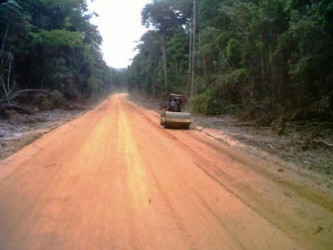While government is still contemplating the future of the Amaila Fall Hydro-power Project (AFHP), should no plans be made to move forward with it, proposals for cost recovery from the US$42M Amaila Falls Access Road will be need to be gauged.

Public Infrastructure Minister David Patterson told Stabroek News that “what we are looking at is seeing some sort of cost recovery on the road. So right now we are doing assessments, who will benefit from the road and so on.”
He revealed that under the existing contracts there is still 18 km left of roadway to be completed as well as remedial work. The minister gave no indication that the government was looking to cease these operations in fact stating that since the contract had already been paid for the work needed to be done.
“What is in the contract contractors will have to finish…we want them to finish because most of the money has been expended. We may as well get the road complete,” he stated.
He said that logging and mining in the areas along the road are both very lucrative stating that a toll could be set up for use of the roadway.
Patterson also noted that the various communities that would benefit from the road will also be assessed if or when a toll is established.
“…Use the monies recouped from that to maintain the road,” Patterson stated, noting that the government was not looking to spend millions in upkeep of a road that has no direct benefit should the AFHP be shelved indefinitely.

In January, former Public Works Minister, under the PPP/C administration, Robeson Benn revealed that the ministry was projecting to spend $200M each year to maintain the access road.
Technical Adviser for the Amaila Falls Access Road, Walter Willis, during the same press conference stated that the road was substantially completed and that it was currently being used with more than 95% of the work done.
Since then, Minister of State, Joseph Harmon had revealed in June that AFHP hinged on an economic feasibility study done by the Inter-American Development Bank (IDB).
At a post-Cabinet press briefing he had noted that the IDB is holding US$80 million from the Guyana-Norway forest protection deal in its accounts as Guyana’s equity in the project and Guyana was also seeking a loan from the Bank for the AFHP.
Harmon’s revelation came after President David Granger had indicated that his administration was unlikely to proceed with the project although he stated that hydropower was still being considered as a viable energy option.
At the time Harmon had reported that IDB vice-president Alexandre Meira da Rosa and General Manager for the Caribbean Department of the Bank, Gerald Johnson were in the country and a report on the feasibility study would be submitted. The study was however not handed over to the government at that point in time and there has been no additional word from the government if this has been done since.
When in opposition, both APNU and the AFC had criticized the Bharrat Jagdeo and Donald Ramotar administrations for the lack of transparency surrounding the AFHP. The AFHP was the flagship project of the Low Carbon Development Strategy and was supported by Norway but has struggled to get off the ground even as it was enveloped in several controversies. Norway last year transferred US$80 million earned by Guyana for limiting deforestation, to the IDB as Guyana’s equity in the project.
Since the project was first announced, costs of the 165-megawatt hydro venture have escalated from the original US$450 million to US$858.2 million up to 2013. The costs for the access road had ballooned from US$15 million when the contract was signed in 2010 to US$43.5 million last year.
Sithe Global, the project developers, had pulled out of the AFHP in August 2013 citing a lack of political consensus. The company had issued a statement saying that unless all three parties in Parliament backed two measures for the controversial US$858M project it would pull out. The measures were not fully supported and the company walked away.





